Hyptis, Mint bush
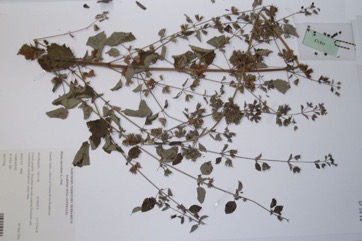
A tropical plant. It grows in dry open locations. It can grow along streams and near roadsides. It can grow up to 1300 m altitude in Papua New Guinea. It grows in seasonally dry climates. In China it grows in open waste places in southern China. In Costa Rica it grows below 1,200 m altitude.
Also known as:
Amotan, Ara gusumpuru, Bhambairam, Bhunsri, Bilati tulsi, Bilayati tulsi, Bointim, Bush tea-bush, Chan, Chia gordo, Dimbubuha, (es) th(ow)m, t(is)a t(oo) d(aj)i, Ganga tulsi, Gros baume, Hierba de las muelas, Jangli silam, Jukut bau, Kara, Konivari, Lampesan, Loko-loko, Lubabibe, Maeng lak kha, Malbar hutan, Mang-kamang, Mintweed, Padja-de-musquito, Palha-mosquito, Pokpok kemangi, Purado, Sangura, Selaseh hutan, Shan xiang, Suob-kabayo, Vilyati tulsi, Wilayati tulsi, Wild basil, Wild spikenard
Synonyms
- Ballota suaveolens L.
- Bysteropogon graveolens (L.) Blume
- Marrubium indicum Thunb. non Burm.f.
- Mesosphaerum suaveolens (L.) Kuntze
- Schauera graveolens (L.) Hasskarl
Edible Portion
- Leaves - tea, Seeds, Leaves, Spice, Vegetable
Where does Hyptis grow?
Found in: Africa, Aruba, Asia, Australia, Bahamas, Bangladesh, Benin, Burkina Faso, Central Africa, Central America, China, Congo DR, Costa Rica, Côte d'Ivoire, East Timor, El Salvador, Ghana, Guiana, Guinea, Guinée, Guinea-Bissau, Guyana, Haiti, Hawaii, Himalayas, India, Indochina, Indonesia, Ivory Coast, Jamaica, Laos, Malaysia, Mexico, Nepal, Nicaragua, Nigeria, North America, Northeastern India, Pacific, Pakistan, Panama, Papua New Guinea, PNG, Paraguay, Peru, Philippines, SE Asia, Senegal, Sierra Leone, South America, Taiwan, Thailand, Timor-Leste, Trinidad, United States, Venezuela, Vietnam, West Africa, West Indies
Notes: It grows naturally in pastures. There are about 350-400 Hyptis species. Most are tropical or subtropical. It is used in medicine.
Growing Hyptis, Mint bush
Cultivation: The plants grow from seeds or cuttings.
Edible Uses: The shoot tips are used as food flavouring. They are also used to make a mint flavoured drink. The seeds are soaked in water and as the seeds soften a slimy coat forms around them and is used as a drink.
Nutrition Info
per 100g edible portion| Edible Part | Energy (kcal) | Protein (g) | Iron (mg) | Vitamin A (ug) | Vitamin c (mg) | Zinc (mg) | % Water |
|---|---|---|---|---|---|---|---|
| - | - | - | - | - | - |
Hyptis, Mint bush Photos

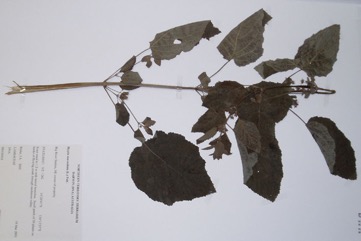
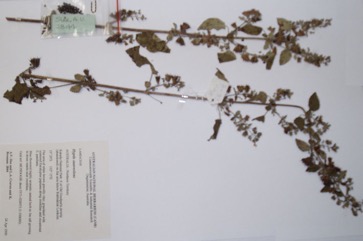
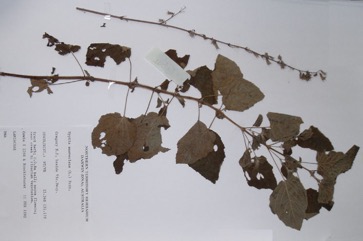
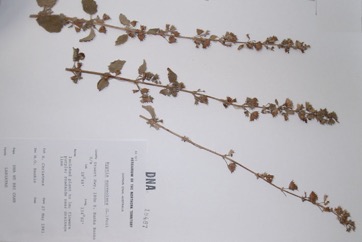
References
Altschul, S.V.R., 1973, Drugs and Foods from Little-known Plants. Notes in Harvard University Herbaria. Harvard Univ. Press. Massachusetts. no. 3942
Ambasta S.P. (Ed.), 2000, The Useful Plants of India. CSIR India. p 282
Ann. Mus. Natl. Hist. Nat. 7:472, t. 29, fig. 2. 1806
Bonou, A., et al, 2013, Valeur economique des Produits Forestiers Non Ligneux (PFNL) au Benin. Editions Universitaires Europeennes p 97
Burkill, H. M., 1985, The useful plants of west tropical Africa, Vol. 3. Kew.
Casas, A., et al, 1996, Plant Management Among the Nahua and the Mixtec in the Balsas River Basin, Mexico: An Ethnobotanical Approach to the Study of Plant Domestication. Human Ecology, Vol. 24, No. 4 pp. 455-478
Chizmar Fernandez, C., et al, 2009, Plantas comestibles de Centroamerica. Instituto de Biodiversidad, Costa Rica. p 213
Cooper, W. and Cooper, W., 2004, Fruits of the Australian Tropical Rainforest. Nokomis Editions, Victoria, Australia. p 237
Cowie, I, 2006, A Survey of Flora and vegetation of the proposed Jaco-Tutuala-Lore National Park. Timor-Lests (East Timor) www.territorystories.nt/gov.au p 49
Dangol, D. R., 2002, Economic uses of forest plant resources in western Chitwan, Nepal. Banko Janakari, 12(2): 56-64
Dobriyal, M. J. R. & Dobriyal, R., 2014, Non Wood Forest Produce an Option for Ethnic Food and Nutritional Security in India. Int. J. of Usuf. Mngt. 15(1):17-37
Facciola, S., 1998, Cornucopia 2: a Source Book of Edible Plants. Kampong Publications, p 126
Flora of Pakistan. www.eFloras.org
Grivetti, L. E., 1980, Agricultural development: present and potential role of edible wild plants. Part 2: Sub-Saharan Africa, Report to the Department of State Agency for International Development. p 26
Grubben, G. J. H. and Denton, O. A. (eds), 2004, Plant Resources of Tropical Africa 2. Vegetables. PROTA, Wageningen, Netherlands. p 562
Henty, E.E., & Pritchard, G.S., 1973, Weeds of New Guinea and their control. Botany Bulletin No 7, Division of Botany, Lae, PNG. p 109
Hussey, B.M.J., Keighery, G.J., Cousens, R.D., Dodd, J., Lloyd, S.G., 1997, Western Weeds. A guide to the weeds of Western Australia. Plant Protection Society of Western Australia. p 168
Kenneally, K.E., Edinger, D. C., and Willing T., 1996, Broome and Beyond, Plants and People of the Dampier Peninsula, Kimberley, Western Australia. Department of Conservation and Land Management. p 112
Kiple, K.F. & Ornelas, K.C., (eds), 2000, The Cambridge World History of Food. CUP p 1788
Kumar, R. & Saikia, P., 2020, Wild edible plants of Jharkhand and their utilitarian perspectives. Indian Journal of Traditional Knowledge Vol 19 (2), April 2020, pp 237-250 (As Mesosphaerum suaveolens)
Kuo, W. H. J., (Ed.) Taiwan's Ethnobotanical Database (1900-2000), http://tk.agron.ntu.edu.tw/ethnobot/DB1.htm
Lazarides, M. & Hince, B., 1993, Handbook of Economic Plants of Australia, CSIRO. p 136
Li Hai-wen, Hedge, I.C., Lamiaceae. Flora of China. p 355
Low, T., 1992, Bush Tucker. Australia’s Wild Food Harvest. Angus & Robertson. p 35
Martin, F.W. & Ruberte, R.M., 1979, Edible Leaves of the Tropics. Antillian College Press, Mayaguez, Puerto Rico. p 196
McMakin, P.D., 2000, Flowering Plants of Thailand. A Field Guide. White Lotus. p 94
Milson. J., 2000, Trees and Shrubs of north-west Queensland. DPI p 90
Paczkowska, G. & Chapman, A.R., 2000, The Western Australian Flora. A Descriptive Catalogue. Western Australian Herbarium. p 273
Peekel, P.G., 1984, (Translation E.E.Henty), Flora of the Bismarck Archipelago for Naturalists, Division of Botany, Lae, PNG. p 486, 487
Petheram, R.J. and Kok, B., 2003, Plants of the Kimberley Region of Western Australia. UWA Press p 159
Plants of Haiti Smithsonian Institute http://botany.si.edu/antilles/West Indies
PROSEA handbook Volume 13 Spices. p 256
Sarma, H., et al, 2010, Updated Estimates of Wild Edible and Threatened Plants of Assam: A Meta-analysis. International Journal of Botany 6(4): 414-423
Segura, S., et al, 2018, The edible fruit species in Mexico. Genet Resour Crop Evol (2018) 65:1767–1793
Seidemann J., 2005, World Spice Plants. Economic Usage, Botany, Taxonomy. Springer. p 181
Terra, G.J.A., 1973, Tropical Vegetables. Communication 54e Royal Tropical Institute, Amsterdam, p 52
Wheeler, J.R.(ed.), 1992, Flora of the Kimberley Region. CALM, Western Australian Herbarium, p 803
World Checklist of Useful Plant Species 2020. Royal Botanic Gardens, Kew (As Mesosphaerum suaveolens)
Zuchowski W., 2007, Tropical Plants of Costa Rica. A Zona Tropical Publication, Comstock Publishing. p 274